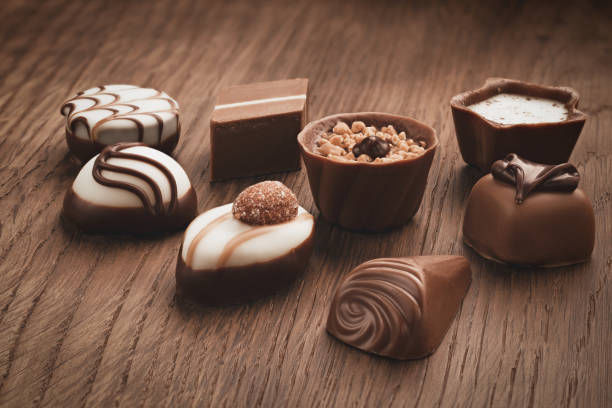Praline is one of those confections that instantly evokes feelings of warmth, indulgence, and sweetness. Whether enjoyed as a crunchy nut candy, a creamy filling, or a silky paste blended into chocolates, praline has a universal appeal. Although its appearance and preparation may vary across regions such as France, Belgium, and the United States, the essence of praline lies in the harmony of nuts, sugar, and often cream or butter. In this article, we will explore the fascinating origins of praline, how it evolved over time, the different types around the world, the traditional and modern methods of preparation, nutritional insights, and some innovative uses in modern gastronomy.
1. The Origin and History of Praline
The story of praline begins in 17th-century France, during the reign of King Louis XIII. According to culinary historians, the creation of praline is often attributed to Chef Clément Lassagne, who worked for the Comte du Plessis-Praslin, a French diplomat. The legend suggests that Lassagne accidentally dropped almonds into boiling caramelized sugar, creating the first version of what would later be called “praline” in honor of his employer, “Praslin.”
At that time, pralines were simply caramel-coated almonds, elegant enough to be served in royal courts. Over the centuries, the concept of praline expanded beyond the French borders, adapting to local ingredients and preferences. When French settlers arrived in Louisiana, USA, they introduced pralines to the New World. However, due to the scarcity of almonds in the region, cooks substituted pecans, which were native and abundant in the American South. The addition of cream and butter transformed the texture from hard candy to something softer, creamier, and distinctively Southern.
Meanwhile, in Belgium, praline evolved into a completely different creation: chocolate pralines—chocolates filled with nutty or creamy centers. This Belgian innovation, credited to Jean Neuhaus in 1912, became a cornerstone of the world’s fine chocolate industry.
Thus, from a simple caramelized nut treat, praline evolved into multiple cultural variations, each beloved for its own unique qualities.
2. Evolution and Global Spread of Praline
As trade routes expanded and culinary exchanges grew more frequent, praline took on many regional forms:
| Region/Country | Type of Nuts Used | Key Ingredients | Texture/Consistency | Common Usage |
|---|---|---|---|---|
| France | Almonds or Hazelnuts | Sugar, sometimes vanilla | Hard and brittle | Eaten as candy or ground into praline paste |
| Belgium | Hazelnuts, Almonds | Chocolate, sugar, butter | Soft filling in chocolates | Chocolate centers or desserts |
| United States (South) | Pecans | Sugar, butter, cream | Soft, fudge-like texture | Handheld candy, dessert topping |
| Switzerland | Almonds or Hazelnuts | Chocolate, milk, sugar | Smooth, creamy | Used in praline-flavored chocolates |
| Germany | Mixed nuts | Sugar, honey, butter | Crunchy | Decorative confectionery and pastries |
Each adaptation demonstrates how praline was never static. It absorbed the essence of local traditions, tastes, and available resources. French pralines focused on simplicity and crisp texture, Belgian pralines embraced sophistication and smoothness, and Southern pralines became synonymous with warmth and comfort.
3. Main Ingredients of Praline
Though recipes vary, certain elements remain fundamental to all praline varieties. Each ingredient contributes not only to the flavor but also to the chemistry that defines the final product’s texture and character.
a. Nuts
The heart of praline lies in the nuts. Traditionally, almonds and hazelnuts are the base, though pecans, walnuts, and macadamias are also used in modern versions. The choice of nut determines both flavor and texture. Almonds provide a delicate crunch and mild sweetness, hazelnuts add rich, buttery depth, and pecans give a Southern charm with their distinctive aroma.
b. Sugar
Sugar acts as both a sweetener and a structural component. In traditional French praline, granulated sugar is caramelized to a deep amber color before nuts are added. The caramelization process not only sweetens but introduces a complex flavor with notes of toffee and slight bitterness that balance the richness of nuts.
c. Butter and Cream
These ingredients are characteristic of the American-style praline. Butter gives a silky texture, while cream softens the mixture into a melt-in-the-mouth candy. The fats from butter and cream also help stabilize the sugar, preventing crystallization and ensuring a smooth finish.
d. Chocolate
In Belgian pralines, chocolate serves as both a shell and a flavoring agent. Dark, milk, or white chocolate can be used depending on preference. The filling often contains ground nuts, cream, or liqueur-infused mixtures, encased in a glossy chocolate coating.
e. Flavor Enhancers
Modern praline makers experiment with vanilla, sea salt, espresso, orange zest, and even chili to add unique flavor dimensions. These ingredients, though optional, can transform a traditional praline into a gourmet experience.
4. Traditional Praline Preparation
The process of making praline depends on its regional type. Below is a general outline of classic French praline preparation, followed by American praline for comparison.
a. French-Style Praline (Caramelized Nuts)
Ingredients:
- 200 g almonds or hazelnuts
- 200 g granulated sugar
- A pinch of salt
Method:
- Roast the Nuts: Roast nuts at 180°C (350°F) for about 10 minutes until fragrant. Roasting enhances their natural oils and flavor.
- Caramelize the Sugar: Heat sugar in a thick-bottomed pan without stirring until it melts and turns golden brown.
- Combine: Add the roasted nuts into the caramel. Stir quickly to coat all nuts evenly.
- Cool and Set: Pour the mixture onto parchment paper and let it cool completely.
- Crush or Grind: Once hardened, it can be broken into pieces or ground into a fine praline powder or paste.
b. American-Style Praline (Creamy Pecan Candy)
Ingredients:
- 2 cups brown sugar
- 1 cup white sugar
- 1 cup heavy cream
- 4 tablespoons butter
- 2 cups pecan halves
- 1 teaspoon vanilla extract
Method:
- Mix and Heat: Combine sugars, cream, and butter in a saucepan. Cook over medium heat until the mixture reaches a soft-ball stage (about 238°F / 114°C).
- Add Nuts and Flavor: Remove from heat, add pecans and vanilla, and stir until the mixture thickens slightly.
- Form Candies: Drop spoonfuls onto parchment paper and allow to cool.
- Serve: Once set, they become soft, creamy candies with a melt-in-your-mouth consistency.
5. Praline in Modern Culinary Applications
Today, praline is more than a standalone treat. It has become a versatile ingredient in the culinary world, appearing in everything from gourmet desserts to flavored beverages.
a. Praline Paste
Finely ground caramelized nuts create a smooth, rich paste used in pastries, ice creams, and chocolates. It can be blended into mousses, layered in cakes, or used as a filling for croissants.
b. Praline Cream
This is a mixture of praline paste and whipped cream or custard. It adds a luxurious nutty sweetness to desserts like éclairs, tarts, or mille-feuille.
c. Praline Chocolate
Belgian chocolatiers popularized praline-filled chocolates, which are often found in assorted chocolate boxes. These pralines may be filled with hazelnut cream, coffee ganache, or even fruit purees.
d. Praline Ice Cream and Beverages
Many ice creams incorporate praline swirls or pieces for added crunch and flavor. Cafés also serve praline lattes and milkshakes, offering a nutty, caramel-rich indulgence.
e. Praline as a Dessert Garnish
Ground praline powder can be sprinkled over cakes, puddings, or yogurt parfaits. It provides texture contrast and a burst of roasted sweetness.
6. Nutritional Value and Health Aspects
While praline is undeniably indulgent, it contains some nutritional benefits, especially when made with wholesome nuts and minimal processed additives. The following table provides an approximate overview per 30 g (1 oz) serving:
| Component | French Praline (Hard) | American Praline (Creamy) |
|---|---|---|
| Calories | 160 kcal | 200 kcal |
| Total Fat | 9 g | 11 g |
| Saturated Fat | 1 g | 5 g |
| Carbohydrates | 16 g | 23 g |
| Protein | 3 g | 2 g |
| Sugars | 15 g | 21 g |
| Fiber | 1 g | 1 g |
Health Considerations:
- Positive aspects: Nuts are rich in healthy fats, vitamin E, magnesium, and antioxidants. In moderation, praline can offer quick energy and beneficial nutrients.
- Concerns: The high sugar and fat content, especially in cream-based pralines, can contribute to excess calorie intake if consumed frequently.
- Healthier alternatives: Replacing white sugar with natural sweeteners like coconut sugar, or using dark chocolate instead of milk chocolate, can make pralines more balanced.
7. The Science Behind Caramelization
The transformation of sugar during praline making is more than visual — it’s chemical. When sugar is heated above 320°F (160°C), it begins to break down and form hundreds of new aromatic compounds. This caramelization process gives praline its distinctive flavor and golden-brown color.
At the molecular level, caramelization involves the decomposition of sucrose into glucose and fructose, followed by further reactions that generate rich flavors. Temperature control is critical: if it’s too low, the sugar won’t caramelize; if it’s too high, it burns and becomes bitter. Mastering this step is key to perfect praline.
8. Artistry and Innovation in Praline Making
In the modern culinary world, praline has transcended tradition. Chefs and chocolatiers constantly innovate with textures, flavors, and presentations.
a. Flavor Fusion
Contemporary pralines feature flavors like sea salt caramel, espresso, matcha, lavender, or whiskey. Each variation appeals to a different palate and demonstrates the adaptability of the base recipe.
b. Vegan and Sugar-Free Pralines
With growing health consciousness, many artisans craft pralines using plant-based cream, coconut milk, and natural sweeteners such as maple syrup or stevia. Vegan pralines retain the nutty caramel appeal without dairy.
c. Artistic Presentation
High-end confectioners treat pralines as art. Some are hand-painted with edible gold, filled with multi-layered centers, or shaped into delicate spheres. Belgian pralines, in particular, are recognized for their elegant shells and meticulous craftsmanship.
d. Industrial Innovation
Modern production methods have introduced temperature-controlled machinery, enrobing systems, and automated molding. However, handmade pralines still maintain an artisanal charm that machines cannot replicate — the glossy caramel and subtle irregularities of handwork add authenticity.
9. Cultural and Festive Significance
Praline has become synonymous with celebration. In France, it is a common treat during festive seasons and weddings. In Louisiana, pralines are deeply rooted in Southern hospitality, often given as gifts during Christmas and Mardi Gras.
Belgian pralines, packaged in luxurious boxes, are an emblem of fine European chocolate craftsmanship and are among the most popular souvenirs purchased by tourists. Across all cultures, praline signifies sweetness, sharing, and affection, symbolizing joy and the art of indulgence.
10. Storage and Shelf Life
Proper storage ensures that praline maintains its texture and flavor.
- Hard pralines (French): Keep in airtight containers at room temperature for up to 3 weeks. Avoid moisture, as humidity causes the sugar to crystallize.
- Creamy pralines (American): Best stored in airtight containers for 1–2 weeks. Refrigeration extends shelf life but may alter texture.
- Chocolate pralines (Belgian): Store in a cool, dry place (around 18°C / 65°F). Avoid refrigeration to prevent condensation on the chocolate surface.
11. Homemade Praline: Tips for Perfection
Making praline at home can be deeply satisfying, but attention to detail matters. Here are some key tips:
- Use a heavy-bottomed pan to ensure even heat distribution and prevent sugar from burning.
- Do not stir caramelizing sugar until it begins to melt naturally; stirring too early can cause crystallization.
- Roast nuts beforehand to intensify their flavor and ensure crispness.
- Work quickly when coating nuts, as caramel hardens fast.
- Use a silicone mat or parchment paper for cooling the mixture.
- For creamy pralines, use a candy thermometer to monitor the soft-ball stage precisely.
- Experiment with flavors like a pinch of sea salt or a drop of orange essence to elevate the taste.
12. Economic and Industrial Importance
Praline has grown into a significant sector of the confectionery industry. The global praline market includes small artisanal producers and major brands like Neuhaus, Godiva, and Leonidas. Belgium alone exports tons of praline-filled chocolates annually, contributing substantially to its economy.
In the United States, pralines have a regional identity tied to the South, with local businesses in New Orleans, Savannah, and Charleston producing handcrafted varieties that attract tourists. The fusion of traditional craftsmanship with modern branding has turned praline from a household treat into a commercial luxury product.
13. Environmental Considerations and Sustainability
As consumer awareness grows, the sourcing of ingredients like nuts and sugar plays a key role in sustainable confectionery. Many producers now emphasize:
- Ethically sourced cocoa for chocolate pralines.
- Fair trade sugar and organic nuts to ensure responsible production.
- Eco-friendly packaging to minimize waste.
Supporting sustainable praline producers ensures that indulgence does not come at the cost of environmental degradation.
14. Praline in Contemporary Dessert Trends
Modern chefs integrate praline in creative ways beyond its traditional form:
- Praline crumble on top of cheesecakes or parfaits.
- Praline buttercream layered in gourmet cupcakes.
- Praline sauce drizzled over pancakes and waffles.
- Frozen praline parfaits for summer desserts.
- Praline-inspired cocktails, blending caramel liqueur and nutty undertones.
The versatility of praline ensures that it remains relevant even as culinary styles evolve.
15. Conclusion
Praline is more than a sweet treat — it is a culinary bridge connecting centuries of tradition, innovation, and cross-cultural influence. From the French courts of the 1600s to the bustling chocolatiers of Brussels and the cozy kitchens of New Orleans, praline has adapted beautifully to different times and tastes. Its combination of caramelized sugar and nuts remains timeless, while modern adaptations continue to push its creative boundaries.
Whether you savor the crisp crack of French praline, the creamy richness of Southern pecan praline, or the refined bite of Belgian chocolate praline, each version tells a story — of craftsmanship, cultural heritage, and the universal love for sweetness.
FAQs
1. What is the main difference between French and American praline?
French praline is a hard candy made of caramelized nuts, typically almonds or hazelnuts. American praline, on the other hand, is softer and creamier, made with pecans, sugar, butter, and cream.
2. Can praline be made without nuts?
Yes, nut-free praline variations exist, where seeds such as sunflower or pumpkin seeds replace nuts. However, the classic flavor and texture come from roasted nuts.
3. How is praline paste different from praline candy?
Praline paste is made by grinding caramelized nuts into a smooth, buttery consistency, while praline candy is the solid, crunchy form.
4. How long does homemade praline last?
Properly stored praline can last up to 2–3 weeks at room temperature. Creamy pralines have a shorter shelf life of about one week unless refrigerated.
5. What makes Belgian praline special?
Belgian praline refers to filled chocolates with smooth nut-based or flavored centers encased in a chocolate shell. Its elegance and refined taste make it distinct from other praline types.









